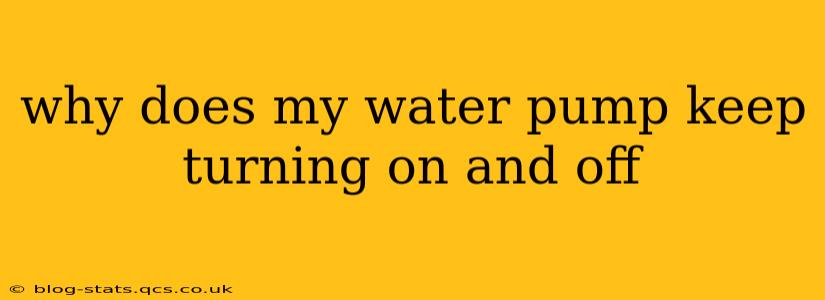A water pump that cycles on and off frequently—a phenomenon often described as "short cycling"—is a common problem that can point to several underlying issues. This annoying and potentially damaging behavior wastes energy and puts unnecessary strain on your pump. Let's delve into the most common causes and how to troubleshoot them.
What Causes a Water Pump to Cycle On and Off?
This problem usually stems from a combination of factors related to water pressure, pump functionality, and the overall water system. Let's explore the key culprits:
1. Low Water Pressure:
This is often the primary reason. If your water pressure is consistently low, the pump will work harder to reach the desired pressure, then shut off once it's achieved. The low pressure quickly drops again, leading to the constant cycling. This could be due to:
- Leaking Pipes: A slow drip or a hidden leak can significantly reduce water pressure, triggering the pump to cycle frequently. Inspect your pipes, fittings, and faucets for any visible leaks.
- Clogged Pipes: Mineral buildup, sediment, or debris can restrict water flow, reducing pressure. This might require professional cleaning or pipe replacement.
- Air in the Lines: Trapped air in your plumbing system can impede water flow, leading to low pressure and pump cycling. This is often remedied by bleeding air from the lines.
- Problems with the Well (if applicable): If you have a well, issues like low water levels, a faulty well pump, or a clogged well screen can all lead to low water pressure.
2. Faulty Pressure Switch:
The pressure switch is a crucial component that controls when the pump turns on and off based on the water pressure. A malfunctioning pressure switch might:
- Be set incorrectly: An improperly adjusted pressure switch can cause the pump to cycle too frequently. Adjusting the settings might resolve the issue.
- Be worn out or damaged: Over time, the pressure switch can wear out, leading to inaccurate readings and erratic cycling. Replacement is often necessary.
3. Defective Pressure Tank:
The pressure tank acts as a buffer, storing water and maintaining pressure. A malfunctioning pressure tank can cause the pump to cycle more often:
- Air Charge Issues: The air bladder inside the pressure tank may lose air, requiring recharging. This involves adding air to the tank using a bicycle pump or specialized pressure gauge.
- Diaphragm Failure: The diaphragm separating the air and water in the tank can rupture, rendering the tank ineffective. Replacement of the pressure tank is typically required.
4. Pump Issues:
While less common, problems with the pump itself can also contribute to short cycling:
- Worn-out pump components: Over time, wear and tear can affect the pump's efficiency, leading to more frequent cycling.
- Impeller problems: A damaged or worn impeller can reduce the pump's ability to move water efficiently.
5. Excessive Water Demand:
If multiple fixtures are used simultaneously, the pump might struggle to keep up, causing it to cycle more frequently. This is less of a fault and more of a symptom of a system needing upgrades.
How to Troubleshoot Your Cycling Water Pump:
- Check Water Pressure: Use a pressure gauge to measure the water pressure. Low pressure is a significant clue.
- Inspect for Leaks: Thoroughly check all pipes, fittings, and faucets for any signs of leaks.
- Listen for Unusual Sounds: Strange noises from the pump or pipes might indicate a problem.
- Check the Pressure Switch: Inspect the pressure switch for any damage or loose connections. Adjust the pressure settings if necessary (consult your pump's manual).
- Check the Pressure Tank: Listen for unusual noises and check the air pressure in the tank. Recharge or replace the tank if needed.
- Consider Professional Help: If you're uncomfortable troubleshooting these issues yourself, calling a qualified plumber is recommended. They can diagnose the problem accurately and make necessary repairs.
By systematically investigating these potential causes, you can identify the source of the problem and restore your water pump to its proper functioning, saving energy and ensuring a reliable water supply.
